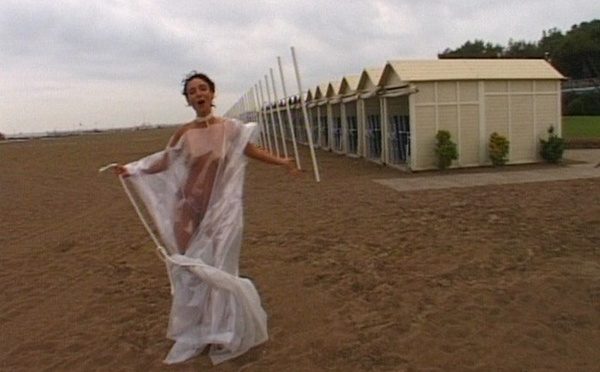When I interviewed Lech Majewski earlier this week, he told me that his central idea for THE GARDEN OF EARTHLY DELIGHTS had been the black box of a crashed aircraft. A love story in Venice filmed entirely using grainy, handheld video cameras à la Dogme 95, the footage presented in the film supposedly represents the findings of this metaphorical black box: a story that would never have come to light had it not entirely crashed and burned.
The film follows an academic of the National Gallery as she travels to Venice in order to continue her research into the work of Bosch. Here, she meets a man with whom she rapidly finds herself sexually and emotionally enchained. The video camera becomes a third figure in their snowballing relationship, filming them as they roam Venice, have sex, and learn about each other. As the woman finds herself to be seriously ill, and her time to be radically shorter than she had anticipated, her investigations into the painting, the man, and herself become desperate, intertwined, and doomed.
The film is the first a trilogy by Lech Majewski that also includes THE MILL AND THE CROSS and ONIRICA. Majewski prefers to refer to the series as a “triptych” given their common inspiration in painting and visual art. Whilst THE GARDEN OF EARTHLY DELIGHTS takes its cues from Bosch’s representations of heaven, hell and Eden, THE MILL AND THE CROSS inhabits Bruegel’s paining “On The Way to Calvary” and ONIRCA takes on Dante’s visual poetry. To understand Majewski’s obsession with the image, its artifice, and its consolations, is to be able to better understand the gravity of his project. THE MILL AND THE CROSS follows the camera inside a painting, using CGI and live action to bring its various dwellings to three-dimensional life, furthering the idea of visual art not just as a springboard for expression and communication but as a kind of harbour to be physically inhabited. THE GARDEN OF EARHTLY DELIGHTS, given the protagonist’s impending ill health, explores this harbouring materiality in the darkest of senses. Hands, arms, mouths grapple at their physical surroundings in the film, begging for communion, or for some kind of self-knowledge through material. The protagonist is constantly pictured standing in front of a projection of Bosch’s image, as if the composite of light on surface might finally merge, leading to mutual inhabitation.
Through the decaying body of the protagonist, the longevity and integrity of the visual image is brought into question. The question “what am I made of?” is asked constantly and obsessively, resulting in a scene in which the two lovers create a display of the different chemicals that make up the human body – carbon represented by coal, for instance, and zinc by a small nail. The thought that the visual image – simple and thin either as oil on canvas or projection on screen – will outlive the human body is a thought which haunts the entire film, and sets up the intriguing legacy of the “black box”. The grain of the video camera is instantly brought into question: the image is often underexposed, out of focus, badly framed, as if itself willing decay. Videos, being themselves but chemicals arranged on a strip, degrade and fragment with each passage through the VHS player, themselves but physical body.
The feeling of visual vulnerability is aligned with fears surrounding the mortality of the human body. Venice emerges as the perfect setting for the film: an architecture harbouring life on a faltering stilts, at any moment capable of tossing an entire civilization, its history, and its images, into the water’s uncompromising dissolve. Where this film might seem pretentious to some is maybe where it is at its most vulernable and its most searching. Watch it because of this. Or because it’s like a weird high-brow, psycho-sexual take on the BLAIR WITCH PROJECT.



Where this film might seem pretentious to some is maybe where it is at its most vulnerable and its most searching
Or maybe not ? For, sometimes, one has sufficiently comprehended a film’s ambitions quite early, and seen that – in its own terms – it failed in them, to make watching to the end to be sure an unnecessary penance. Especially during a festival (as against an ordinary screening), it is prudent enough to save time and energy for something else, and leave.
Then, though, it is useful when a review actually tells a little too much, and one has confirmed that, not just in the best of his novels, Russell Hoban easily outdid such a visual depiction of the topic of doomed love : as an artist who had worked as an illustrator and well knew art history, Russ is just as capable, in the prose of his novels, as any film-maker of bringing in painting, and the world of the arts, whereas one must doubt whether this film actually goes beyond the early territory of Turtle Diary (the only novel, as yet, made into a film).